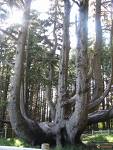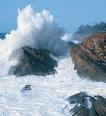Teacher Page
A WebQuest for 4th - 6th Grade Social Studies
Designed by Cathy Kabanuk
Homepage
Contact Me






Introduction
| Learners
| Standards
| Process
| Resources
| Evaluation
| Conclusion
| Credits
| Student
Page
|
Introduction This lesson was developed as a dual project for two MAT courses: Technology Across the Curriculum, and Social Studies Methods.
This lesson will
introduce students to the diverse geography of Oregon. It focuses
natural areas such as mountain ranges, coastline, and desert, or
websites that feature natural history or native peoples of those
natural areas.
Learners This lesson is anchored in fifth grade social studies and involves language arts and computer applications to a lesser extent. It can easily be extended to fourth grade or middle school as well, by modifying the writing assignment and evaluation rubric. In addition, this WebQuest lends itself well to alternate activities, explained in more detail in the Process section below. Students should be somewhat comfortable navigating websites before undertaking this WebQuest. They should also have some background knowledge in note-taking for a project or report. A mini-lesson on printing pictures from the internet may be necessary. Curriculum Standards Social Studies Standards Addressed
Process The teacher should be familiar with printing pictures from the internet. Students may have trouble determining whether photos will print within a reasonable size, and with recognizing whether a photo is from a site that is copyrighted. This lesson is multidisciplinary and will span the course of several days. Suggested timeline is that the first two sessions will be in the computer lab, with students researching the webpages, taking notes, and printing photos. The second session would give students the opportunity to return to favorite sites for more detailed notes and to print photos. This process will go more smoothly with an aide and perhaps a parent volunteer or two to help with printing photos. The second phase is the writing process. Students will select their favorite place from each of the five regions to feature in their brochures. They will write a sloppy copy and go through the editing process, then transfer their polished copy to the brochure. You could have them print on the brochure, write on notebook paper cut to size and paste in the brochure, or word-process their pieces, depending upon your preference and their skill. The WebQuest itself is divided by regions, each opening in a new window, and has a number of links to sites to visit in each of those regions. A variety of sites are included to meet different interests, but it is not expected that students will read every one of them. The instructions explain to students to choose the sites that look most interesting to them. They choose their favorite site from each region to include in their travel brochure. More advanced students may include more than one. To complete this task students will need notebook paper, notecards, or a spiral for note-taking, and a pencil. I suggest that they use notebook paper for note-taking when they initially explore the sites, then use index cards for detailed note-taking on the places they have selected to include in their brochures. They will also need the template for the brochure, along with the instructions for completing it. After completing the trek they will write write a short article about each of the five places they choose to feature - one from each region - and print a photo from the internet for each entry. They will then paste those materials in the areas provided on the template, following your special instructions. At the end of the project students will present their brochures to the class. I suggest that the class be divided into groups, with one group at a time positioned to show their brochures and answer questions as the other groups navigate the room and see what other students have featured and why. You may wish to provide a worksheet for students to take notes about other students' featured places, making this an opportunity to reinforce learning about Oregon's geography. Variations This WebQuest lends itself well to projects other than the brochure described here, such as in internet treasure hunt where students find answers to questions by reading the featured websites, map reading, written and oral reports, jigsaws, or poster presentations. Middle or high school students could design and format the brochure in a computer application rather than than the method of cutting and pasting on a template as described here. Resources Needed A template for the brochure is linked to the WebQuest, along
with instructions on using it. No special resources are needed beyond
the obvious computer lab with printer, and materials needed for writing
and pasting. During the computer sessions it may be advantageous to
have an aide and/or parent volunteer on hand to assist students. Evaluation Students will be evaluated individually on the thoroughness of investigation, careful note-taking, the quality of finished project, and class presentation. Scoring Rubric
Beginning 1 Developing 2 Accomplished 3 Exemplary Score Conclusion This lesson will introduce students to the beauty and geographical diversity of Oregon. At the same time it gives students the opportunity to practice writing skills in a way that is creative, authentic, and takes individual interests into consideration. Students reinforce their computer skills as well. Credits & References Special thanks to all of the websites
linked to the WebQuest for their great information and public service, and for their contributions to education.
All images are from Google Images except for the picture of the governor. Here are the links: Octopus Tree Hell's Canyon Mt. Hood Painted Hills Cape Arago Wave Multnomah Falls Oregon Caves Owyhee Governor Kulongoski The pdf files were created with Microsoft Word. Last updated on December 15, 2007. Based on a template from The WebQuest Page |
|||||||||||||||||||||||||||||||||||||